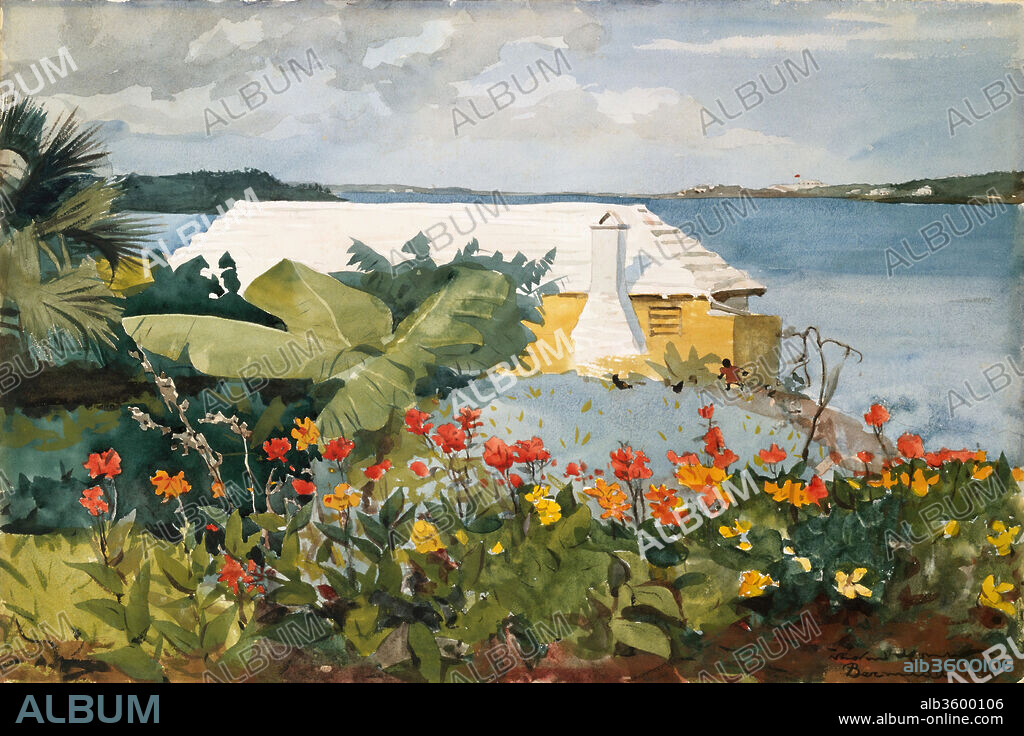alb3600106
WINSLOW HOMER. Flower Garden and Bungalow, Bermuda
¿Ya tienes cuenta? Iniciar sesión
¿No tienes cuenta? Regístrate
Compra esta imagen.
Selecciona el uso:

Autor:
Título:
Flower Garden and Bungalow, Bermuda
Descripción:
Traducción automática: Flower Garden y Bungalow, Bermudas. Artista: Winslow Homer (American, Boston, Massachusetts 1836-1910 Prouts Neck, Maine). Dimensiones: 13 15/16 x 20 15/16. (35,4 x 53,2 cm). Fecha: 1899. A partir de 1884, Homer hizo muchas visitas invernales a lugares tropicales y la acuarela se convirtió en su medio preferido mientras viajaba. En contraste con sus pesadas y cuidadosamente consideradas acuarelas de Cullercoats, sus cuadros tropicales tenían un manejo más ligero y una composición menos formal. A fines de 1885 y principios de 1886, se fue a Florida, pintando en Tampa y Key West. Regresó en 1890, se quedó en la comunidad pesquera de Enterprise en el río St. Johns y pintó acuarelas notables por sus lavados fluidos y delicadas armonías de color. Durante el invierno de 1898-1899, Homer estuvo una vez más en las Bahamas. En uno de los períodos más productivos de sus últimos años, creó al menos veinticinco acuarelas, que se distinguen de las de 1884-1885 por una luz aún más brillante, colores más saturados, trazos más amplios y mucho menos uso de dibujo subyacente a lápiz. Cantidades similares y un manejo aún más flexible se encuentran en acuarelas como esta, que pintó durante su visita a las Bermudas en 1899. Las acuarelas maduras de Homer son sugerentes y experimentales, respuestas inmediatas a la experiencia visual. Aunque estas obras parecen sencillas, fueron cuidadosamente planeadas, e incluso las más seguras revelan los cambios y correcciones del artista. "Verás, en el futuro viviré de mis acuarelas", se dice que dijo Homer. Su vaticinio fue acertado: sus acuarelas le proporcionaron buenos ingresos, nunca han dejado de ser admiradas y su influencia en los artistas de las generaciones venideras ha sido profunda.
Flower Garden and Bungalow, Bermuda. Artist: Winslow Homer (American, Boston, Massachusetts 1836-1910 Prouts Neck, Maine). Dimensions: 13 15/16 x 20 15/16 in. (35.4 x 53.2 cm). Date: 1899.
Beginning in 1884, Homer made many winter visits to tropical locations and watercolor became his preferred medium while traveling. In contrast to his weighty and carefully considered Cullercoats watercolors, his tropical pictures were lighter in handling and less formal in composition. In late 1885 and early 1886, he went to Florida, painting in Tampa and Key West. He returned in 1890, staying in the fishing community of Enterprise on the St. Johns River and painting watercolors notable for their fluid washes and delicate color harmonies. During the winter of 1898-99, Homer was once again in the Bahamas. In one of the most productive periods of his later years, he created at least twenty-five watercolors, distinguished from those of 1884-85 by even brighter light, more saturated colors, broader strokes, and far less use of pencil underdrawing. Similar quantities and even looser handling are found in the watercolors such as this one, which he painted during his visit to Bermuda in 1899.
Homer's mature watercolors are suggestive and experimental, immediate responses to visual experience. Although these works look effortless, they were carefully planned, and even the most assured among them reveals the artist's changes and corrections. "You will see, in the future I will live by my watercolors," Homer is reported to have said. His prediction was accurate: his watercolors provided him with a handsome income, they have never ceased to be admired, and their influence on artists of succeeding generations has been profound.
Técnica/material:
Watercolor and graphite on off-white wove paper
Museo:
Metropolitan Museum of Art, New York, USA
Crédito:
Album
Autorizaciones:
Tamaño imagen:
6230 x 4158 px | 74.1 MB
Tamaño impresión:
52.7 x 35.2 cm | 20.8 x 13.9 in (300 dpi)
Palabras clave:



 Pinterest
Pinterest Twitter
Twitter Facebook
Facebook Copiar enlace
Copiar enlace Email
Email



